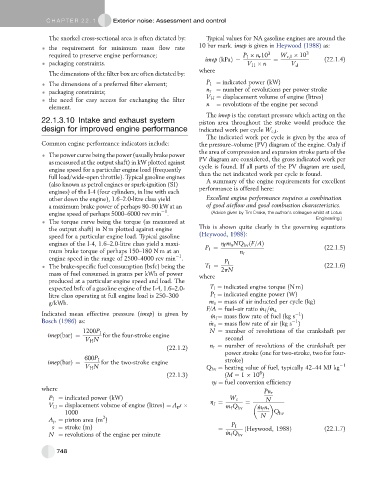Page 737 - Automotive Engineering Powertrain Chassis System and Vehicle Body
P. 737
CHAP TER 2 2. 1 Exterior noise: Assessment and control
The snorkel cross-sectional area is often dictated by: Typical values for NA gasoline engines are around the
10 bar mark. imep is given in Heywood (1988) as:
the requirement for minimum mass flow rate
required to preserve engine performance; P I n r 10 3 W c;I 10 3
imep ðkPaÞ¼ ¼ (22.1.4)
packaging constraints. V H n V d
where
The dimensions of the filter box are often dictated by:
The dimensions of a preferred filter element; P I ¼ indicated power (kW)
packaging constraints; n r ¼ number of revolutions per power stroke
the need for easy access for exchanging the filter V H ¼ displacement volume of engine (litres)
element. n ¼ revolutions of the engine per second
The imep is the constant pressure which acting on the
22.1.3.10 Intake and exhaust system piston area throughout the stroke would produce the
design for improved engine performance indicated work per cycle W c,I .
The indicated work per cycle is given by the area of
Common engine performance indicators include: the pressure–volume (PV) diagram of the engine. Only if
the area of compression and expansion stroke parts of the
The powercurve being thepower (usually brake power
as measured at the output shaft) in kW plotted against PV diagram are considered, the gross indicated work per
engine speed for a particular engine load (frequently cycle is found. If all parts of the PV diagram are used,
full load/wide-open throttle). Typical gasoline engines then the net indicated work per cycle is found.
(also known as petrol engines or spark-ignition (SI) A summary of the engine requirements for excellent
engines) of the I-4 (four cylinders, in line with each performance is offered here:
other down the engine), 1.6–2.0-litre class yield Excellent engine performance requires a combination
a maximum brake power of perhaps 80–90 kWat an of good airflow and good combustion characteristics.
1
engine speed of perhaps 5000–6000 rev min . (Advice given by Tim Drake, the author’s colleague whilst at Lotus
Engineering.)
The torque curve being the torque (as measured at
the output shaft) in N m plotted against engine This is shown quite clearly in the governing equations
speed for a particular engine load. Typical gasoline (Heywood, 1988):
engines of the I-4, 1.6–2.0-litre class yield a maxi- h m a NQ ðF=AÞ
f
hv
P I ¼ (22.1.5)
mum brake torque of perhaps 150–180 N m at an n r
1
engine speed in the range of 2500–4000 rev min .
P I
The brake-specific fuel consumption (bsfc) being the T I ¼ 2pN (22.1.6)
mass of fuel consumed in grams per kWh of power where
produced at a particular engine speed and load. The
expected bsfc of a gasoline engine of the I-4, 1.6–2.0- T I ¼ indicated engine torque (N m)
litre class operating at full engine load is 250–300 P I ¼ indicated engine power (W)
g/kWh. m a ¼ mass of air inducted per cycle (kg)
F/A ¼ fuel–air ratio _ m = _ m a
f
Indicated mean effective pressure (imep) is given by 1
_ m ¼ mass flow rate of fuel (kg s )
f
Bosch (1986) as: 1
_ m a ¼ mass flow rate of air (kg s )
N ¼ number of revolutions of the crankshaft per
1200P I
imepðbarÞ¼ for the four-stroke engine
V H N second
n r ¼ number of revolutions of the crankshaft per
(22.1.2)
power stroke (one for two-stroke, two for four-
600P I stroke)
imepðbarÞ¼ for the two-stroke engine
V H N Q hv ¼ heating value of fuel, typically 42–44 MJ kg 1
6
(22.1.3) (M ¼ 1 10 )
h f ¼ fuel conversion efficiency
where
Pn r
P I ¼ indicated power (kW) W c N
h ¼ ¼
f
V H ¼ displacement volume of engine (litres) ¼ A p s m Q hv _ m n r
f
f
1000 N Q hv
2
A p ¼ piston area (m )
s ¼ stroke (m) ¼ P I ðHeywood; 1988Þ (22.1.7)
N ¼ revolutions of the engine per minute _ m Q hv
f
748

